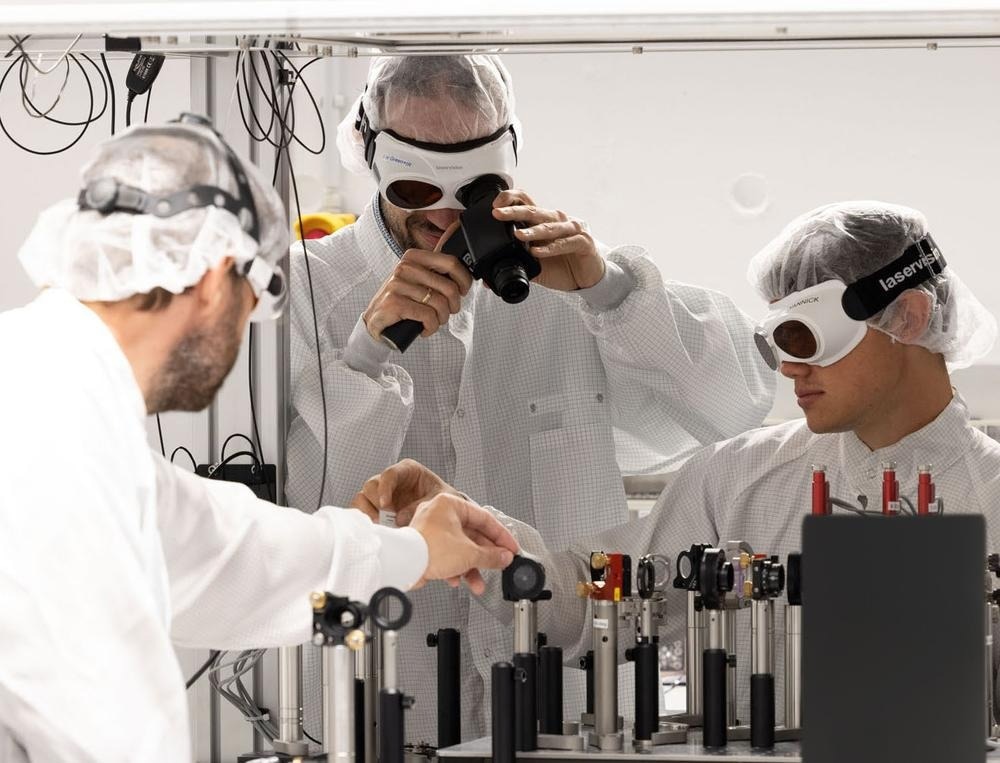An interdisciplinary research team has developed a groundbreaking technique wherein laser light beams can be deflected solely using air through an innovative approach. This invisible air-based grating not only remains impervious to laser light damage but also maintains the beam's initial quality. The team has submitted a patent application for this method, as reported in the journal Nature Photonics.

The development team in the clean room working on the acoustic laser optics. Image Credit: DESY, Angela Pfeiffer
This pioneering method involves utilizing sound waves to modulate the air within the area through which the laser beam passes.
“We’ve generated an optical grating with the help of acoustic density waves,” details first author Yannick Schrödel, a Ph.D. Student at DESY and Helmholtz Institute Jena.
Using specialized loudspeakers, the researchers create a pattern of alternating dense and less dense regions in the air, effectively producing a striped grating. This density pattern functions akin to how variations in air density influence the bending of light in Earth's atmosphere, essentially serving as an optical grating that alters the laser beam's direction.
However, deflecting light by diffraction grating allows much more precise control of the laser light compared to deflection in the Earth's atmosphere. The properties of the optical grating are influenced by the frequency and intensity – in other words, the volume – of the sound waves.
Yannick Schrödel, PhD Student, Deutsches Elektronen-Synchrotron
In the first laboratory tests, a strong infrared laser pulse could be redirected in this way with an efficiency of 50%. Significantly higher efficiencies should be possible in the future, according to numerical models. For the first test, the scientists had to turn their special loudspeakers way up.
“We are moving at a sound level of about 140 decibels, which corresponds to a jet engine a few meters away. Fortunately, we are in the ultrasound range, which our ears don’t pick up,” adds scientist Christoph Heyl from DESY and the Helmholtz Institute Jena, who is leading the research project
The team sees great potential in the technique for high-performance optics. In their experiments, the researchers used an infrared laser pulse with a peak power of 20 gigawatts, which corresponds to the power of around two billion LED bulbs. Lasers of this and even higher power classes are used, for example, for material processing, in fusion research, or for the latest particle accelerators.
In this power range, the material properties of mirrors, lenses, and prisms significantly limit their use, and such optical elements are easily damaged by strong laser beams in practice. In addition, the quality of the laser beam suffers. In contrast, we’ve managed to deflect laser beams in a quality-preserving way without contact.
Christoph Heyl, Scientist, Deutsches Elektronen-Synchrotron
The scientists emphasize that the concept of acoustically controlling laser light in gases extends beyond generating optical gratings. It is likely applicable to other optical components, such as lenses and waveguides.
We’ve been thinking about this method for a long time and quickly realized that extreme sound levels are necessary. At first, these seemed technically unfeasible. However, we did not give up and finally found a solution with the support of researchers at the Technical University of Darmstadt as well as the company Inoson. First, we tried out our technique with ordinary air. Next, for example, we will also use other gases in order to tap into other wavelengths and other optical properties and geometries.
Christoph Heyl, Scientist, Deutsches Elektronen-Synchrotron
Directly deflecting light into the surrounding atmosphere, as previously demonstrated, presents exciting possibilities, particularly as a rapid switch for high-power lasers.
“The potential of contactless control of light and its extension to other applications can currently only be imagined,” notes Heyl. “Modern optics is based almost exclusively on the interaction of light with solid matter. Our approach opens up a completely new direction.”
The research involved contributions from teams at the Technical University of Darmstadt, Aalen University of Applied Sciences, Universität Hamburg, Inoson GmbH in St. Ingbert, the Helmholtz Institute Jena, and DESY.
Journal Reference
Schrödel, Y., et al. (2023). Acousto-optic modulation of gigawatt-scale laser pulses in ambient air. Nature Photonics. doi.org/10.1038/s41566-023-01304-y.
Source: https://www.desy.de/index_eng.html